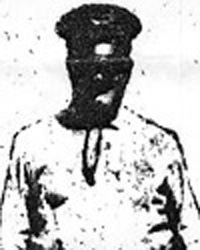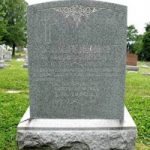North College Hill Marshal Peter Dumele | North College Hill
North College Hill Marshal Peter Dumele
 Age: 53
Age: 53
Served: 3 years
1925 to April 8, 1928
OFFICER
Peter was born in Hungary. He served in the police department in his native country, rising to the rank of Sergeant, and then in the military (artillery) for six years. Peter immigrated to the United States about 1907.
The Village of North College Hill elected him Marshal during 1925. He was a popular and dedicated servant of the people of North College Hille and serving his second term in 1928.
INCIDENT
During the early hours of Easter Morning on April 8, 1928, a gang of six to eight men armed with sawed-off, semi-automatic shotguns and revolvers, each wearing a black mask over his chin and mouth, entered William Warnken’s Pelican Club Poolroom at Hamilton and Sunshade Avenues. The club was clearly a speak easy, gambling enterprise common to almost every local community during Prohibition.
The leader of the gang stepped to the center of the room and ordered; “Everybody step to the walls and put up your hands up! … If one of you moves, we’ll blow your brains out!” He then went over to Lee Staib, who had not yet put his hands up, grabbed him by the shoulder, jerked him around and smashed him in the face with the butt of his revolver. They gang then coolly and methodically robbed each of the twenty patrons of his cash and ordered Warnken to open the safe.
Marshal Dumele had just finished his rounds and was heading home when he noticed the light on in the pool room. He saw confusion in the windows and found the door locked. Warnken saw the Marshal at the door. Warnken pleaded with the gang’s leader; “Men, here comes the Marshal. For God’s sake, don’t hurt him. He’s a good guy.”
Two of the bandits opened the door and covered Marshal Dumele with their revolvers. Marshal Dumele walked into the tense atmosphere of the smoky room and Warnken pleaded with him, “For God’s sake, Pete, please put up your hands.” Marshal Dumele reached for his rear pocket and his revolver. “Give it to him, men!” the leader ordered. Two shotguns and a revolver exploded into him. A revolver bullet passed through Marshal Dumele’s body. A shotgun blast tore off his hand and shattered his arm. The other shotgun blast went into his chest. Marshal Dumele collapsed to the floor.
One of the robbers pointed his shotgun at Warnken and pulled the trigger, but Warnken had suddenly dropped to his knees to aid Marshal Dumele. The shotgun blast instead went into the back of Samuel Keller, another of the patrons. Keller also collapsed to the floor.
The bandits fled to an automobile and escaped north on Hamilton Avenue, taking $1000 of the business’s money with them.
Both Marshal Dumele and Keller were transported to Good Samaritan Hospital in Cincinnati.
DEATH
Marshal Dumele’s wife, Eva Dumele, was brought to Good Samaritan. He told her, “Mama, I wouldn’t be a coward. Rather than be a coward, I would die for my village.” A brief time later, at 5 a.m., he did.
Marshal Dumele was also survived by his adopted daughter. He was buried on April 12, 1928 in old Section E-64 (now Section E, Lot 64), 80 feet northeast of the maintenance building at St. Mary’s Cemetery of Mt. Healthy.
INVESTIGATION
Four people were eventually identified in the murder and others are suspected. Their identification, captures, trials, and convictions were complicated by mob threats and at least one murder. During the trial, holdup victims, and even Mrs. Dumele, were threatened. Mrs. Dumele was assigned a bodyguard.
One holdup victim, Robert H. Andres of Covington, identified Rodney Ford as one of the murderers. He was found shot through the back of his head and his body burned in a West Miami River Road roadside fruit stand.
Rodney Ford, of 964 W. 8th Street, of Cincinnati was charged with 1st Degree Murder in Andres’s murder. He was tried by a jury of eight women and four men. Assistant Deputy Prosecutors Walter K. Sibbald and John Clippinger asked for the death penalty. Edward Ballard and John Scanlon were his defense attorneys. Six witnesses identified Ford. Craven Knox testified in Ford’s trial that he had also seen Ford and Messner fleeing from Monroe, Ohio shortly after another bandit, “Smokey” had been shot to death in an attempted bank robbery. The case went to the jury on January 2, 1929. He was found guilty. He was electrocuted at 8:35 p.m. on July 19, 1929; 1¼ years after Marshal Dumele’s murder.
Robert “Bob” Zwick of Newport, also known as “The Fox,” was a well-known Newport gangster with George Remus and Al Capone associations. He was as much feared in the southwestern Ohio Valley as was Dillinger. The Chicago mafia viewed him as a witness that needed to be eliminated and he survived multiple attempts on his life while committing robberies in Ohio and Kentucky. After five years on the run, he was finally wounded and captured during a shootout with a Toledo policeman during January 1933. He was convicted of 1st Degree Murder in the Andres murder and sentenced to life imprisonment on April 8, 1933. He was indicted in Marshal Dumele’s murder, but never tried. During 1968, he was pardoned in the Andres murder and Marshal Dumele’s indictment was nulled. He died peacefully in a Cincinnati nursing home at the age of 99 during January 1997.
John (Todd or Toddy) Messner of Hamilton was once called “one of the most desperate criminals who ever went out of Hamilton to follow the paths of gangland.” He had been involved in bootlegging, rum running, hijacking and possibly other vices in Butler County for several years. Messner was involved in the 1925 murder of Eddie Schief in Hamilton – which indirectly resulted in the murder of Seven Mile Prohibition Agent Robert O. Gary – and was acquitted when key witnesses either disappeared or suddenly lost their memories on the witness stand. He was, however, convicted in the Marshal Dumele murder and sentenced to life in prison. He was paroled in the 1960s and died in Butler County during 1971.
Breck Lutes of Middletown had also been involved in bootlegging, rum running, hijacking and possibly other vices in Butler County for several years. He was convicted in the Marshal Dumele murder and sentenced to life in prison. He was paroled in the 1960s and died January 15, 1989, in Manatee County, Florida.
Suspects included Jack Parker, but he was slain near Lebanon in a gangland feud.
Robert Cary fled to Detroit in 1916 from his birthplace in St. Louis after the murder of Harry “Cherries” Dunn during a spat between the Egan’s Rats and Hogan’s gangs. He traveled the Midwest with Fred “Killer” Burke, Gus Winkler, and James Ray. Between 1927 and 1929, he is believed to have been involved in a dozen murders; a double-murder in Detroit (1927), Patrolman Zientara’s murder in Toledo (1928), Marshal Dumele’s murder, the St. Valentine’s Day Massacre in Chicago (1929), and a murder of gangster in Los Angeles (1929). He and his girlfriend were found shot to death in bed in New York City on July 31, 1932. New York Police declared it a Murder/Suicide.
Another suspect was possibly Raymond “Crane Neck” Nugent of Cincinnati, an Al Capone hit man. Eight days after the North College Hill incident, April 16, 1928, Nugent was involved in Toledo Patrolman George Zientara’s murder during an armored car robbery. On February 14, 1929, he was one of the shooters in the Valentine’s Day Massacre in Chicago. Though never brought to justice by the law, while running a business in Florida where he bought his alcohol from the “wrong” source, during April 1931 he is alleged to have been escorted into the Everglades in Florida and fed to the alligators. Family lore has him murdered and set adrift on a burning boat down the Ohio River. Regardless of the method of his demise, justice was better served to him outside the courtroom.
The last possible suspect was Fred “Killer” Burke, another Capone hit man. Burke was also involved in the 1928 Toledo Patrolman Zientara’s murder and he planned and executed the St. Valentine’s Day Massacre in Chicago on February 14, 1929. On December 14, 1929, he killed Patrolman Charles Skalay of the St. Joseph (Michigan) Police Department and was then captured. During his life, he was involved in many other robberies and murders throughout the United States, but only convicted of killing Patrolman Skalay; for which he plead to a charge of 2nd Degree Murder and sentenced to life in prison. He died of a heart attack while in prison on July 10, 1940.
If you know of any information, artifacts, archives, or images regarding this officer or incident or the suspects, please contact the Greater Cincinnati Police Museum at Memorial@Police-Museum.org.
© This narrative was further researched and revised on April 1, 2019 by Cincinnati Police Lieutenant Stephen R. Kramer (Retired), Greater Cincinnati Police Historical Society Vice President. All rights are reserved to him and the Greater Cincinnati Police Historical Society.
